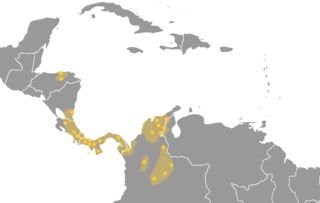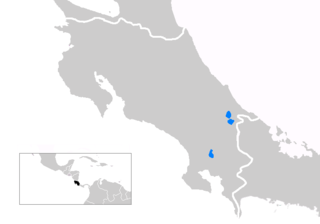Related Research Articles

The Chibchan languages make up a language family indigenous to the Isthmo-Colombian Area, which extends from eastern Honduras to northern Colombia and includes populations of these countries as well as Nicaragua, Costa Rica, and Panama. The name is derived from the name of an extinct language called Chibcha or Muysccubun, once spoken by the people who lived on the Altiplano Cundiboyacense of which the city of Bogotá was the southern capital at the time of the Spanish Conquista. However, genetic and linguistic data now indicate that the original heart of Chibchan languages and Chibchan-speaking peoples might not have been in Colombia, but in the area of the Costa Rica-Panama border, where the greatest variety of Chibchan languages has been identified.

Costa Rican culture has been heavily influenced by Spanish culture ever since the Spanish colonization of the Americas including the territory which today forms Costa Rica. Parts of the country have other strong cultural influences, including the Caribbean province of Limón and the Cordillera de Talamanca which are influenced by Jamaican immigrants and indigenous native people, respectively.

Limón is one of seven provinces in Costa Rica. The province covers an area of 9,189 km2, and has a population of 386,862.

The Bribri are an Indigenous people in eastern Costa Rica and northern Panama. Today, most Bribri people speak the Bribri language or Spanish.
Talamanca is a canton in the Limón province of Costa Rica. The head city is Bribri, located in Bratsi district.

Bribri, also known as Bri-bri, Bribriwak, and Bribri-wak, is a Chibchan language, from a language family indigenous to the Isthmo-Colombian Area, which extends from eastern Honduras to northern Colombia and includes populations of those countries as well as Nicaragua, Costa Rica, and Panama. As of 2002, there were about 11,000 speakers left. An estimate by the National Census of Costa Rica in 2011 found that Bribri is currently spoken by 54.7% of the 12,785 Bribri people, about 7,000 individuals. It is a tonal language whose word order is subject–object–verb.
Costa Rica's official and predominant language is Spanish. The variety spoken there, Costa Rican Spanish, is a form of Central American Spanish.

This is an Index of Central America-related articles. This index defines Central America as the seven nations of Belize, Costa Rica, El Salvador, Guatemala, Honduras, Nicaragua, and Panama.
The Cabécar language is an indigenous American language of the Chibchan language family spoken by the Cabécar people in the inland Turrialba Region, Cartago Province, Costa Rica. As of 2007, 2,000 speakers were monolingual. It is the only indigenous language in Costa Rica with monolingual adults. The language is also known by its dialect names Chirripó, Estrella, Telire, and Ujarrás.
Bribri may refer to:
The Talamanca languages are a well-defined branch of Chibchan languages spoken in central–southern Costa Rica and northern Panama. They are:
Costa Rican agriculture plays a profound part in the country's gross domestic product (GDP). It makes up about 6.5% of Costa Rica's GDP, and 14% of the labor force. Depending upon location and altitude, many regions differ in agricultural crops and techniques. The main exports include: bananas, pineapples, coffee, sugar, rice, vegetables, tropical fruits, ornamental plants, corn, potatoes and palm oil.

Indigenous people of Costa Rica, or Native Costa Ricans, are the people who lived in what is now Costa Rica prior to European and African contact and the descendants of those peoples. About 114,000 indigenous people live in the country, comprising 2.4% of the total population. Indigenous Costa Ricans strive to keep their cultural traditions and language alive.

The Cabécar are an indigenous group of the remote Talamanca region of eastern Costa Rica. They speak Cabécar, a language belonging to the Chibchan language family of the Isthmo-Colombian Area of lower Central America and northwestern Colombia. According to census data from the National Institute of Statistics and Census of Costa Rica, the Cabécar are the largest indigenous group in Costa Rica with a population of nearly 17,000.
The Kingdom of Talamanca was a political entity existing during the historic period covered from the Executive Decree issued by the Costa Rican government on July 25, 1867, recognizing the Talamanca indigenous monarchs as "political chiefs" of the region, until the death of their last king Antonio Saldaña in 1910, apparently poisoned, and who died without heirs thus putting an end to the line of succession.

Antonio Saldaña was a Bribri cacique and the last king of Talamanca in Costa Rica.
The Indigenous Territory of Kéköldi is one of the Costa Rican indigenous communities and one of the four of the Bribri people. It was created in 1977 and has about 210 inhabitants. It is located in the Talamanca-Caribe biological corridor that covers about 36,000 hectares in the canton of Talamanca, Limón Province. Since 1994, the reserve is run by the Kéköldi Wak ka Köneke Association, which works to preserve indigenous culture and purchase additional land to reforest and conserve. The majority of the population speaks both Bribri and Spanish. The reserve has a biological station for scientific research and a bird watching area for tourists.
The Bribri Talamanca Indigenous Territory is one of the four Costa Rican indigenous territories of the Bribri ethnic group. It borders the Talamanca Cabecar Indigenous Territory. It was created by decree in 1985 and is located in the canton of Talamanca, Limón Province. It covers an approximate area of 43,690 hectares of a predominantly mountainous area.

Sibú is the primary deity in the Talamancan mythology of Costa Rica. He is the creator of Earth and humanity, god of wisdom, values, and indigenous customs. He is called Sibú by the Bribri and Cabécar, Sibö by the Teribe, and Zipoh by the Boruca.
Sibotherium is an extinct genus of ground sloth in the family Megatheriidae that lived in what is now Costa Rica during the Late Miocene. It was a large ground sloth, weighing more than 2,500 kg.
References
- ↑ Bribri Sign Language at Ethnologue (25th ed., 2022)
